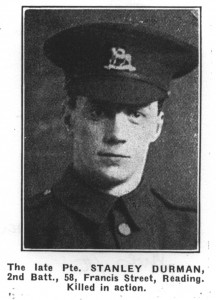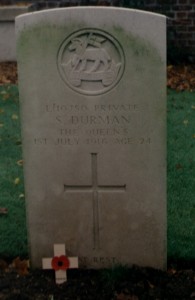Joseph Duce
Private G/9219 6th Battalion
The Queen’s (Royal West Surrey Regiment)
Division 67
Extension
Joseph Duce was the son of Clara Duce, of 197, High Street, Watford, Hertfordshire, and the late David Duce. According to the 1911 census the family had a Fish Restaurant in Watford. Joseph died on 12th May 1917, aged 37. He has no known grave and is commemorated on the Arras Memorial to the Missing, Bay 2.
The Battle of Bullecourt is described in detail in “The Blood Tub” by Jonathan Walker. The Battle of Arras began on 9th April 1917 along a twelve mile front. Starting with the success of the taking of Vimy ridge by the Canadians the battle became more and more bloody as the British and Australians tried to break through the Hindenburg line renewing the attack with more vigour on 3rd May. Losses were heavy and “the only remedy seemed to be to put more and more brigades into the ‘Blood tub’”. (page 163)
Walker describes the attack of the 12th May 1917 in his chapter “Fight for the Crucifix”. In the forefront was the 2nd Queens. This battalion had been decimated during 1st Ypres and was now made up mostly of men of “Kitchener’s Army”. It is therefore likely that Joseph Duce was serving in this Battalion at the time of the attack and his death. The attack was timed to begin at 3.40am on 12 May. The men were very tired because even when out of line they were required to bring supplies forward. They got off to a good start, with the 1st South Staffordshires on their left and the Australians on the right, advancing quickly under the German barrage.
The Queen’s reached their objectives but battle got bogged down on along the line either side of them. True to form the battle became drawn out over the following days and although the German counter-attacks failed there were many casualties, killed, missing and wounded. Amongst them was Joseph Duce whose body was never identified.

